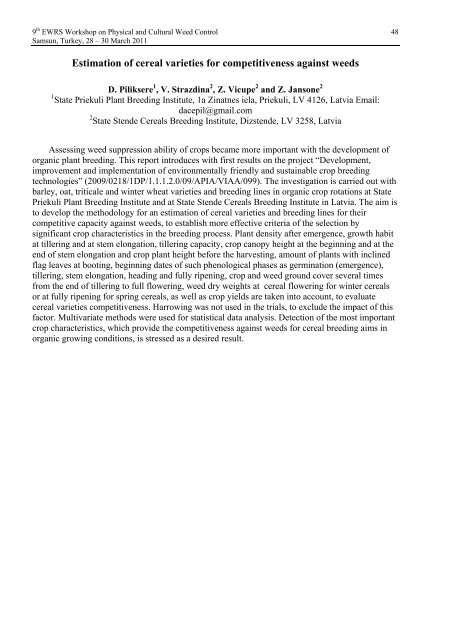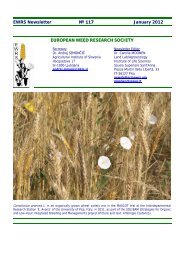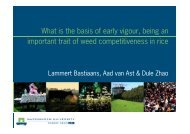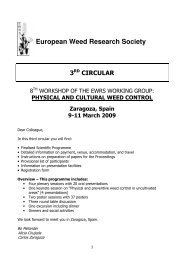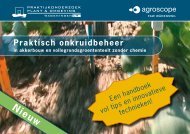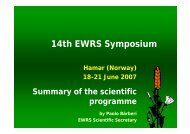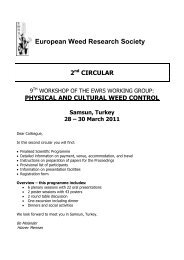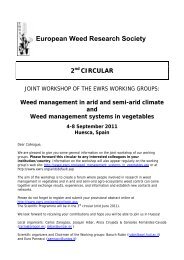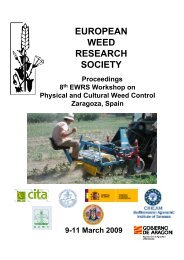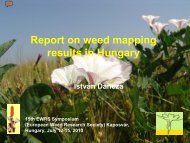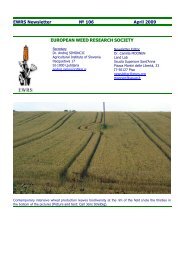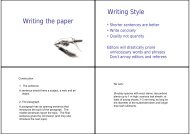Physical and Cultural Weed Control Working Group of - European ...
Physical and Cultural Weed Control Working Group of - European ...
Physical and Cultural Weed Control Working Group of - European ...
You also want an ePaper? Increase the reach of your titles
YUMPU automatically turns print PDFs into web optimized ePapers that Google loves.
9 th EWRS Workshop on <strong>Physical</strong> <strong>and</strong> <strong>Cultural</strong> <strong>Weed</strong> <strong>Control</strong> 48<br />
Samsun, Turkey, 28 – 30 March 2011<br />
Estimation <strong>of</strong> cereal varieties for competitiveness against weeds<br />
D. Piliksere 1 , V. Strazdina 2 , Z. Vicupe 2 <strong>and</strong> Z. Jansone 2<br />
1 State Priekuli Plant Breeding Institute, 1a Zinatnes iela, Priekuli, LV 4126, Latvia Email:<br />
dacepil@gmail.com<br />
2 State Stende Cereals Breeding Institute, Dizstende, LV 3258, Latvia<br />
Assessing weed suppression ability <strong>of</strong> crops became more important with the development <strong>of</strong><br />
organic plant breeding. This report introduces with first results on the project “Development,<br />
improvement <strong>and</strong> implementation <strong>of</strong> environmentally friendly <strong>and</strong> sustainable crop breeding<br />
technologies” (2009/0218/1DP/1.1.1.2.0/09/APIA/VIAA/099). The investigation is carried out with<br />
barley, oat, triticale <strong>and</strong> winter wheat varieties <strong>and</strong> breeding lines in organic crop rotations at State<br />
Priekuli Plant Breeding Institute <strong>and</strong> at State Stende Cereals Breeding Institute in Latvia. The aim is<br />
to develop the methodology for an estimation <strong>of</strong> cereal varieties <strong>and</strong> breeding lines for their<br />
competitive capacity against weeds, to establish more effective criteria <strong>of</strong> the selection by<br />
significant crop characteristics in the breeding process. Plant density after emergence, growth habit<br />
at tillering <strong>and</strong> at stem elongation, tillering capacity, crop canopy height at the beginning <strong>and</strong> at the<br />
end <strong>of</strong> stem elongation <strong>and</strong> crop plant height before the harvesting, amount <strong>of</strong> plants with inclined<br />
flag leaves at booting, beginning dates <strong>of</strong> such phenological phases as germination (emergence),<br />
tillering, stem elongation, heading <strong>and</strong> fully ripening, crop <strong>and</strong> weed ground cover several times<br />
from the end <strong>of</strong> tillering to full flowering, weed dry weights at cereal flowering for winter cereals<br />
or at fully ripening for spring cereals, as well as crop yields are taken into account, to evaluate<br />
cereal varieties competitiveness. Harrowing was not used in the trials, to exclude the impact <strong>of</strong> this<br />
factor. Multivariate methods were used for statistical data analysis. Detection <strong>of</strong> the most important<br />
crop characteristics, which provide the competitiveness against weeds for cereal breeding aims in<br />
organic growing conditions, is stressed as a desired result.


